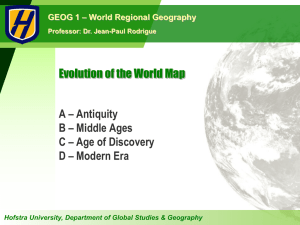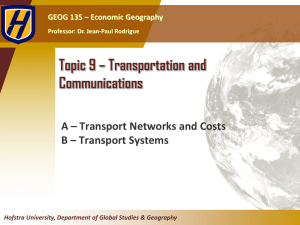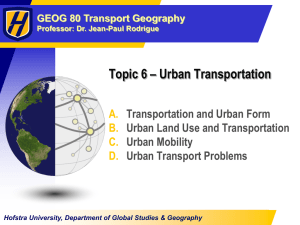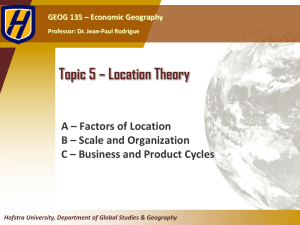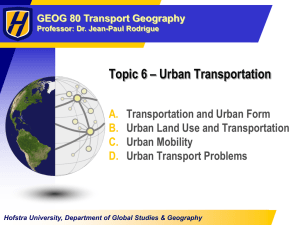File - OCHS History and Geography
advertisement
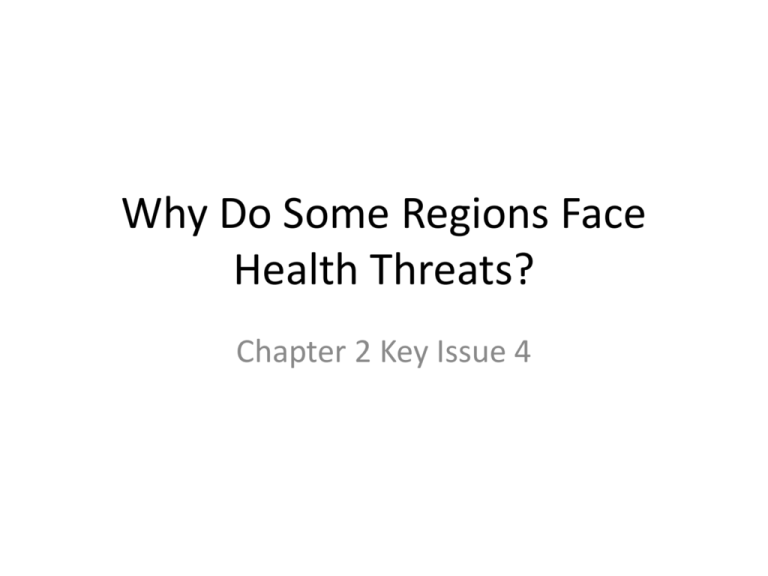
Why Do Some Regions Face Health Threats? Chapter 2 Key Issue 4 The Epidemiologic Character of Population Phenomena ■ epi, upon; demos, people; logos, study ■ Epidemiology is the study of what “comes upon” groups of people. ■ Epidemiology is concerned with the distribution of disease and death, and with their determinants and consequences in population groups. © Dr. Jean-Paul Rodrigue 1. EPIDEMIOLOGICAL TRANSITION Concept Focuses on changes over time in the causes of mortality affecting certain populations: Health conditions. Disease patterns. Result in a decline in death rates and an increase of life expectancy. The society goes through a transition from communicative diseases to degenerative diseases. 1. Epidemiological Transition Age of communicative diseases Age of receding pandemics Age of degenerative and man-made diseases Share of mortality Degenerative diseases Low Fertility Low Mortality High Fertility High Mortality LI=70 years LI=30 years LI=50 years Communicative diseases High Fertility Decreasing Mortality Time © Dr. Jean-Paul Rodrigue The Epidemiologic Transition © Dr. Jean-Paul Rodrigue The Epidemiologic Transition Stage 1: Pestilence and Famine ■ Infectious and parasitic diseases ■ Epidemics • Example Black Plague ■ High CDR © Dr. Jean-Paul Rodrigue The Epidemiologic Transition Stage 2: Receding Pandemics ■ Improved sanitation, nutrition, & medicine during Industrial Revolution ■ Rapidly Declining CDR © Dr. Jean-Paul Rodrigue © Dr. Jean-Paul Rodrigue Cholera in London, 1854 Fig. 2-23: By mapping the distribution of cholera cases and water pumps in Soho, London, Dr. John Snow identified the source of the water-borne epidemic. © Dr. Jean-Paul Rodrigue Epidemics and Pandemics in Popular Literature ■ Stephen King’s book, The Stand ■ Brad Pitt, Bruce Willis & Madeline Stowe in the movie “The Twelve Monkeys” ■ Albert Camus’ novel, The Plague ■ Charlton Heston in “Omega Man” & Vincent Price in “The Last Man on Earth” based on Richard Matheson’s novel, I Am Legend ■ Edgar Allan Poe’s short story “The Masque of the Red Death” (also a Vincent Price movie) © Dr. Jean-Paul Rodrigue The Epidemiological Transition Stage 3 – Degenerative & humancreated diseases ■ Chronic Disorders associated with aging • Cardiovascular diseases (hear attacks) & cancer ■ Moderately Declining CDR © Dr. Jean-Paul Rodrigue The Epidemological Transition Stage 4: Delayed degenerative diseases ■ Cardiovascular diseases and cancers ■ BUT life expectancy of older people extended through medical advances • Cancer growth retarded or removed • Bypass to repair cardiovascular system ■ High Obesity rates • Non-nutritious food/sedentary lifestyle ■ Low but increasing CDR © Dr. Jean-Paul Rodrigue © Dr. Jean-Paul Rodrigue Sprawl & Obesity © Dr. Jean-Paul Rodrigue Sprawl and Health Concerns ■ Because this study is ecologic and cross-sectional in nature, it is premature to imply that sprawl causes obesity, hypertension, or any other health condition. ■ Our study simply indicates that sprawl is associated with certain outcomes. ■ Future research using quasi-experimental designs is needed to tackle the more difficult job of testing for causality. “Relationship Between Urban Sprawl and Physical Activity, Obesity, and Morbidity” by Reid Ewing, Tom Schmid, Richard Killingsworth, Amy Zlot, Stephen Raudenbush in the American Journal of Health Promotion, Inc., September/October 2003, Vol. 18, No. 1 © Dr. Jean-Paul Rodrigue Sprawl, Weight and Blood Pressure © Dr. Jean-Paul Rodrigue The Epidemiological Transition Stage 5 – Reemergence of infectious & parasitic diseases ■ Evolution • Antibiotics and genetic engineering • Emergence of new strains of viruses and bacteria ■ Poverty • Unsanitary conditions in developing countries ■ Increased Connections • Spreads from Developing to developed countries © Dr. Jean-Paul Rodrigue © Dr. Jean-Paul Rodrigue © Dr. Jean-Paul Rodrigue Global Warming & Disease Spread ■ It is possible that if global warming occurs, the occurrence and range of infectious disease might shift significantly. ■ Areas previously not prone to widespread outbreaks of malaria, might experience a significant increase in its incidence. © Dr. Jean-Paul Rodrigue Avian Flu, 2003 - 2006 Fig. 2-25: The first cases of avian flu in this outbreak were reported in Southeast Asia. © Dr. Jean-Paul Rodrigue © Dr. Jean-Paul Rodrigue HIV/AIDS Prevalence Rates, 2005 Fig. The highest HIV infection rates are in sub-Saharan Africa. India and China have large numbers of cases, but lower infection rates at present. © Dr. Jean-Paul Rodrigue Health Care ■ Indicators of Health • Infant Mortality rate • Life Expectancy ■ Provision of Health Care • Health Care expenditures • Available Medical Services © Dr. Jean-Paul Rodrigue Infant Mortality Rates Fig. 2-10: The infant mortality rate is the number of infant deaths per 1000 live births per year. The highest infant mortality rates are found in some of the poorest countries of Africa and Asia. © Dr. Jean-Paul Rodrigue Life Expectancy at birth Fig. 2-11: Life expectancy at birth is the average number of years a newborn infant can expect to live. The highest life expectancies are generally in the wealthiest countries, and the lowest in the poorest countries. © Dr. Jean-Paul Rodrigue Health Care per Capita © Dr. Jean-Paul Rodrigue Government Expenditures on Health Care © Dr. Jean-Paul Rodrigue © Dr. Jean-Paul Rodrigue
